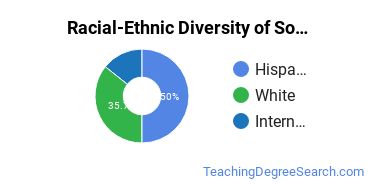Social & Philosophical Foundations of Education at University of New Mexico - Main Campus
What traits are you looking for in a social and philosophical foundations of education school? To help you decide if University of New Mexico - Main Campus is right for you, we've gathered the following information about the school's social and philosophical foundations of education program.UNM is located in Albuquerque, New Mexico and approximately 22,311 students attend the school each year.
Want to know more about the career opportunities in this field? Check out the Careers in Social & Philosophical Foundations of Education section at the bottom of this page.
UNM Social & Philosophical Foundations of Education Degrees Available
- Master’s Degree in Social and Philosophical Foundations of Education
UNM Social & Philosophical Foundations of Education Rankings
There were 4 students who received their doctoral degrees in social and philosophical foundations of education, making the school the #12 most popular school in the United States for this category of students.
Social and Philosophical Foundations of Education Student Demographics at UNM
Take a look at the following statistics related to the make-up of the social and philosophical foundations of education majors at University of New Mexico - Main Campus.
UNM Social & Philosophical Foundations of Education Master’s Program

In the social and philosophical foundations of education master's program at this school, racial-ethnic minorities make up 63% of degree recipients. That is 10% better than the national average.*
The following table and chart show the race/ethnicity for students who recently graduated from University of New Mexico - Main Campus with a master's in social and philosophical foundations of education.

| Race/Ethnicity | Number of Students |
|---|---|
| Asian | 0 |
| Black or African American | 0 |
| Hispanic or Latino | 5 |
| White | 2 |
| International Students | 1 |
| Other Races/Ethnicities | 0 |
References
*The racial-ethnic minorities count is calculated by taking the total number of students and subtracting white students, international students, and students whose race/ethnicity was unknown. This number is then divided by the total number of students at the school to obtain the racial-ethnic minorities percentage.
- College Factual
- National Center for Education Statistics
- O*NET Online
- Image Credit: By PerryPlanet under License
More about our data sources and methodologies.
